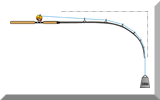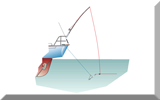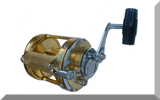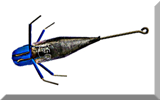- Home
- Especially for Fishing Boat Owners
- Fishing Boat Trailers
What to Look for in Fishing Boat Trailers
It sounds obvious, but fishing boat trailers must be
matched to the boat they're carrying - and many
aren't. A bit short-sighted this, as if the trailer fails, the boat, the car and maybe even the occupants could all be seriously damaged.
Your fishing boat trailer should be big enough for your boat, but no bigger.
So first, check the manufacturer's plate, which will be fitted somewhere on the trailer. This will tell you the maximum boat weight the trailer is designed for.
Exceed it at your peril - at best your insurance won't pay out in the event of damage, and much worse, the police will have something to say to you in the event of an accident.
Matching Trailer to Boat
Boat weight means the all-up weight, including fuel, water, fishing tackle and any other stuff you may be transporting along with it.
Choosing a trailer too light for the job in hand can be really dangerous.
The basic rule is that the all-up weight plus the weight of the trailer should be less than the maximum laden weight of the trailer.
Other important rules include:~
- The boat should overhang the trailer by not more than a moderate amount;
- The boat should be positioned on the trailer such that the weight distribution results in about 5% to 10% resting on the ball hitch. This will go a long way to avoiding the risk of fish-tailing. If this happens, it's something that's likely to stay in your memory for a long time;
- The third factor of the fishing boat trailer equation is the towing vehicle. If this isn't up to the job, the driver may quickly find things getting far more interesting than he'd like.
It was on the slipway in front of the Royal Albert Bridge Inn on the River Tamar near Plymouth. A rather nice 25ft fishing boat was being reversed by a seriously inadequate Ford Escort family car. The boat slipped on the trailer, changing the weight distribution and lifting the rear wheels of the car.
In some regards it was a successful launch - but it did include the car.
Trailer Construction
With dunkings in saltwater a regular event for fishing boat trailers, corrosion is a constant threat. Painted or powder coated fishing boat trailers may look fine for a while, but unseen they'll be rotting from the inside out.
A trailer manufactured from galvanized steel sections will avoid this - it's the only way to go really.
Some trailers have the running gear structure welded to the trailer frame, others have it bolted on. The bolted rout offers an advantage in that the running gear can be repositioned, allowing the optimum all-up weight distribution to be achieved.
Suspension
Multi-leaf springs are fine for many trailer types but not for those that get regular saltwater dunkings. The springs will soon corrode together and any suspension ability become little more than a memory.
Either a single-leaf, or better still a torsion bar suspension system is the way to go.
Number of Axles
For boats up to around 20 feet overall, a single-axle trailer will be fine. Longer than that and you'll need a twin-axle type.
The single-axle type is simpler to maintain, cheaper, and much easier to manoeuvre by hand.
Trailer Brakes
Only one way to go here - over-run brakes. These are independent of the towing vehicle brakes and are operated when the towing vehicle slows putting a compressive load on the over-run mechanism.
The harder the towing vehicle applies its brakes, the greater the force exerted on the trailer's over-run brakes.
Hull Supports
There are two approaches to supporting the boat on its trailer:~
- bunks, or
- rollers

Bunks are flat wooden planks, traditionally protected by strips of old carpet, positioned to match the hull shape.
It's essential that these provide support right to the boat's transom, or you risk deforming the boat's hull.
The alternative approach involves rollers located on articulated arms...

These are self-adjusting and enable self-centering - a very useful attribute when recovering your boat in strong winds or cross currents.
Another benefit of roller trailers is that you need less water to launch your boat than you would with a bunk trailer.
Maintaining Your Fishing Boat Trailer
Saltwater is the scourge of fishing boat trailers and this factor is a large part of preventative maintenance.
Here are the key points:~
- As soon as you can after launching or recovering your boat, give the trailer a thorough wash down with fresh water, taking particular care to flush any seawater out of the wheels and brake mechanisms;
- Use an anti-corrosion spray (WD40 for example) on all moving trailer parts.
- Check the wheel bearings. If the wheels down turn freely, or 'grumble', think seriously about replacing the bearings. Sealed bearing units will give far better service than traditional taper bearings;
- while you've got the wheels off the ground, undo the wheel nuts and grease the threads;
- Check the tyre pressures. If you don't have a spare wheel, think about getting one, and check the pressure in that too;
- Keep the cup on the tow hitch well greased.
One other good piece of advice is not to be in too much of a rush to launch the boat if you've towed it for any distance.
Give the brakes and wheel bearings time to cool down before you immerse them. About 15 to 20 minutes should do it.
All ready? Go catch!
Recent Articles
-
Sea Fishing Rods and Reels Must Be Compatible for a Balanced Outfit
Mar 08, 21 08:30 AM
A quality reel fitted to a quality rod doesn't necessarily make it a quality outfit. Your fishing rods and reels have to be properly matched if you're to get the best out of them, and here’s how -
Essential Lure Fishing Tips That All Saltwater Anglers Should Know
Mar 08, 21 04:51 AM
Which single lure fishing tip applies to trolling, jigging, baitcasting, spinning, fly fishing and any other branch of lure fishing? Well, it is the one at the top of this list -
Vital Jig Fishing Tips That You Really Cannot Afford To Miss!
Mar 07, 21 10:20 AM
Essential jig fishing tips to help you select the right lure for successful jig fishing, together with the techniques required to get the most out of your jig fishing outfit




























New! Comments
Have your say about what you've just read! Leave me a comment in the box below.